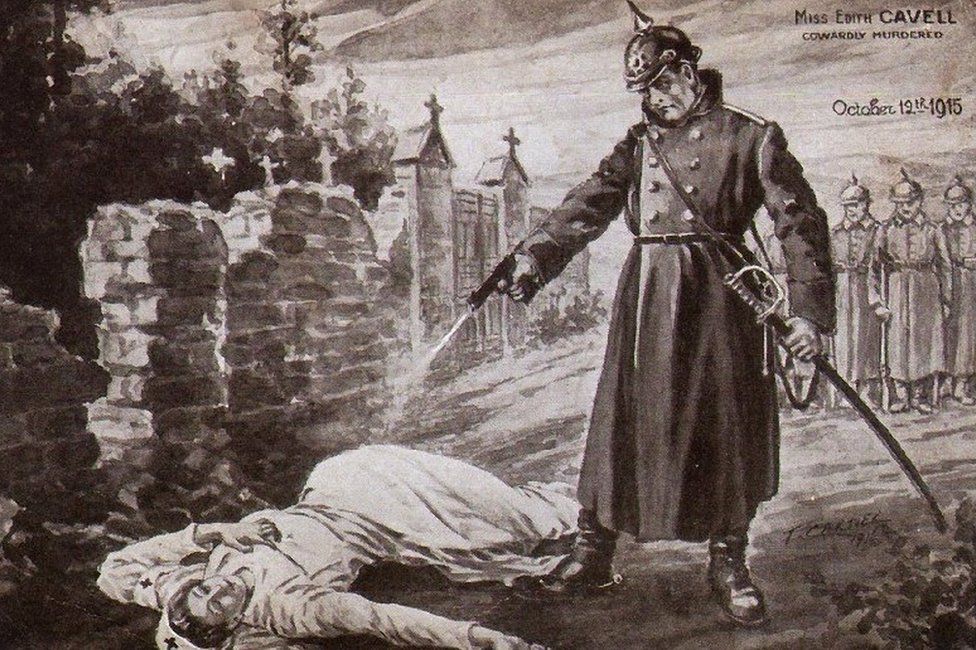Nurse Edith Cavell and the British World War One propaganda campaign
- Published

Edith Cavell died as a pioneering nurse exactly 100 years ago, executed by the German army on 12 October 1915 for helping British soldiers get home from Belgium. Her death became notorious across the world, and she was celebrated as a martyr for freedom. But with all the propaganda that followed, how much do we truly know about the woman who was revered as a heroine?
A vicar's daughter born at Swardeston, near Norwich, Edith Cavell worked as a nurse at the Berkendael Institute in Brussels from 1907, where she helped pioneer modern nursing techniques in Belgium.
She was arrested for treason in August 1915 for helping more than 200 Allied soldiers escape occupied Belgium before being shot by the Germans two months later at the age of 49.
Her body was exhumed in 1919, given a military escort to Dover and then taken to a packed Westminster Abbey for a memorial ceremony.
Crowds gathered to see Cavell finally laid to rest in the grounds of Norwich Cathedral.
So celebrated is she that there is a statue commemorating her life in Westminster, London.
Her death made a big impact in Britain, its empire and the wider world, with memorials in London, Norwich, Melbourne and Brussels, and she even had a mountain named after her in Canada.
Edith Cavell was buried at Norwich Cathedral
In the immediate aftermath of her death, the nurse was used heavily in the British propaganda drive - a campaign that sometimes obscured the real Edith Cavell.
Laura Clouting, historian at the Imperial War Museum, said: "World War One was the first time propaganda was used as a weapon of war. It starts off very early on with the German advance through Belgium and focuses on the perceived outrages by the Germans. It is in this atmosphere that the use of Edith Cavell's death can be seen.
"It was used to galvanise public opinion against the Germans."
Across the British empire, Cavell's death was used to spur the recruitment of soldiers.
In Canada one poster features a picture of Cavell bearing the slogan "Murdered by the Huns" and urges people to "Enlist in the 99th (Essex battalion, of the Canadian Expeditionary Force) and help stop such atrocities".
In Britain, recruitment numbers rose from 5,000 to 10,000 a week following her death.
Life of Edith Cavell
- Born on 4 December 1865, the eldest of four children, in Swardeston, a village near Norwich
- In 1896, started training to be a nurse at the Royal London Hospital under Matron Eva Luckes, a friend of Florence Nightingale
- Completed her nursing training in 1898 and in 1907 became matron at the first nursing school in Belgium
- On holiday in England when war breaks out, she quickly returns to Belgium. She soon begins helping Allied troops get home
- Cavell is arrested in August 1915 by German troops who find her guilty of treason under a German military code - this allowed foreigners to be convicted of treason
- Her role of a nurse, ordinarily protected under the Geneva Convention, was seen to have been forfeited as she was helping Allied soldiers escape
- After a trial, at 07:00 on 12 October she is executed by firing squad
Recruits were needed by the British army to replace those lost on the Western Front - conscription was not introduced until 1916.
Cavell's death was also used to encourage support for Britain among neutral countries.
Early news reports often distorted the truth of her death, apparently for propaganda purposes.
Even the American Journal of Nursing repeated the fictional account of Cavell's execution in which she refused a blindfold for the execution and then fainted. The German commanding officer then shot her dead with a pistol, according to this account. The story featured on a number of postcards.
She is also often depicted wearing a nursing uniform when she was a shot by the firing squad, which she had made a point of not wearing as she was not being shot for her nursing.
Edith Cavell commemoration
- Norwich Cathedral: Commemorative Service, Monday 12 October, 18:00 BST. Preacher: The bishop
- Norwich Cathedral: A commissioned exhibition of 14 paintings by Brian Whelan on The Passion of Edith Cavell: The Way of the Cross will be on display until 22 October
- London: On 12 October at 10:30 BST, alongside nurses from the Royal London Hospital and members of the Army, the Cavell Nurses' Trust will be holding a ceremonial wreath-laying marking 100 years since Cavell's death, at her statue near Trafalgar Square
- London: From 19:30 BST, a performance of the Eventide in Memoriam to Edith Cavell and Faure Requiem at St Clement Danes church in The Strand
- Peterborough Cathedral: On 17 October from 19:30 BST: The Edith Cavell Centenary Concert - Peterborough Cathedral Choir, Youth Choir and Festival Chorus will perform a programme of music from the 1914-18 period.
Cavell's biographer Diana Souhami said the nurse's death "was used for propaganda purposes" and as a "clarion call for getting soldiers to join the army".
"They saw Cavell as this innocent victim," she said.
But Ms Souhami believes this is a distorted image of her.
"Times have so changed now - there is not the same patronising attitude towards women," Ms Souhami told the BBC.
"We can now see her for what she did. She knew she was part of this network (to rescue Allied soldiers).
"I think she should be remembered as a pioneering hospital matron and remembered as an intrepid war hero who, with great courage and guile, helped get soldiers out of the country to safety," she said.
"She should not be seen as a victim."
- Published5 January 2013
- Published12 October 2005
- Published9 May 2002